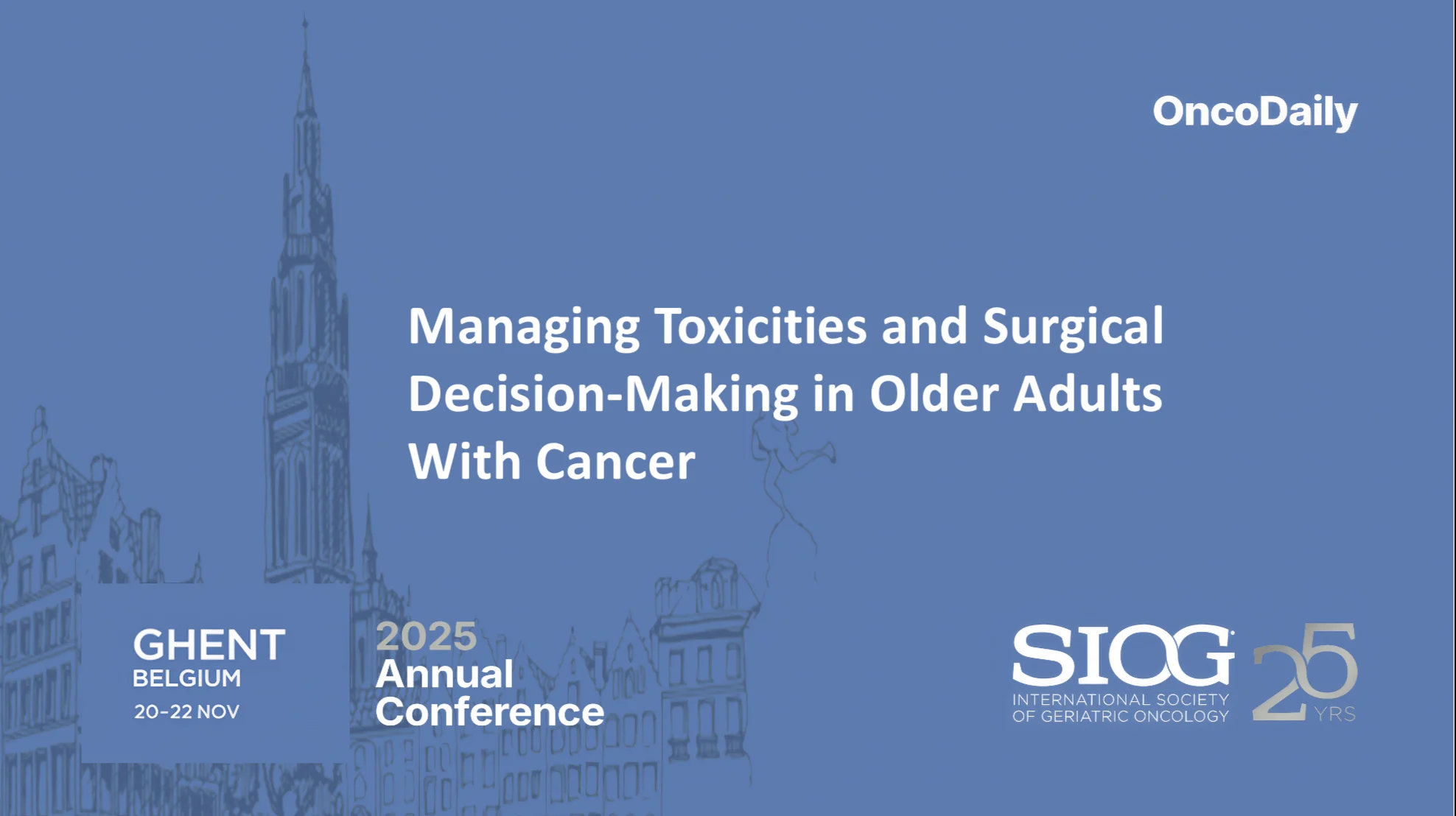The SIOG 2025 Annual Conference brought together experts from medical oncology, geriatrics, surgery, nursing, and digital health to examine one of the most challenging and increasingly common scenarios in oncology: managing cancer treatment toxicities in older adults with multimorbidity, frailty, complex social circumstances, and limited access to care. Using a single case presentation to structure the discussion, speakers explored the nuances of immune-related adverse events (irAEs), the impact of surgery in older populations, the central role of nursing, and the emerging promise of wearable technologies to support real-world monitoring.
Case Presentation and Immune Checkpoint Inhibitor Toxicities in Older Adults
Speaker: Colm Mac Eochagain (Dublin, Ireland)
The case presented—a 78-year-old older adult treated with immunotherapy and living with comorbidities, polypharmacy, and functional decline—served as a catalyst for discussion across all talks. Gonzalez-Senac underscored that the toxicities often considered “mild” in clinical trials can have far more profound consequences in real-world older adults. Although multiple organizations have published guidelines for managing immune checkpoint inhibitor (ICI)–related toxicities, most assume physiologically robust patients and rarely address how to adapt management for baseline organ impairment, frailty, or vulnerability.
A key finding highlighted was that grade 3–4 toxicity rates are not necessarily higher in older adults, but the impact of toxicities is far greater. Older patients face increased risks of hospitalization, prolonged recovery, and permanent treatment discontinuation. Multi-organ irAEs appear more common with advancing age, possibly due to immunoregulation changes or polypharmacy interactions.
Frailty—not chronological age—emerged as the strongest predictor of unplanned hospitalization and early mortality. Toxicity-prediction tools commonly used in oncology (such as CARG) were designed for chemotherapy and are not validated for ICIs. Combination immunotherapy regimens nearly double the rate of high-grade toxicity compared with monotherapy and are especially difficult to complete in older adults.
Pre-existing autoimmune disease, once a strict contraindication, is now considered manageable. About half of older adults with autoimmune conditions experience disease flare, most commonly in rheumatologic or GI disorders. Rechallenge after ICI toxicity carries a recurrence risk of around 40%, though recurrent events tend to be of similar or lower grade. Decisions must be individualized around the patient’s comorbidities, functional status, and goals.
Fatigue remains one of the most pervasive and underreported toxicities affecting about one-fifth of older patients. It may signal endocrine irAEs such as hypothyroidism or adrenal insufficiency, and requires careful assessment for depression, anemia, sleep disturbance, and nutritional deficits.
Colitis, particularly with CTLA-4 agents, poses disproportionate risks for frail adults due to dehydration, acute kidney injury, and cognitive impairment. A low threshold for hospitalization is essential. Rash, though often perceived as minor, can significantly impair self-care in patients with fragile skin. Neurotoxicity, though rare, can masquerade as delirium, requiring baseline cognitive assessments and broad differential diagnosis.
Musculoskeletal irAEs such as inflammatory arthritis or myositis frequently compromise independence. Distinguishing degenerative osteoarthritis from immunotherapy-induced rheumatologic toxicity often requires comparison of baseline and updated imaging.
Endocrine toxicities such as hypothyroidism may present atypically in older adults—fatigue, cognitive slowing, or depressive symptoms. Thyroid replacement should be titrated carefully with attention to cardiovascular risk.
Corticosteroids remain first-line therapy for most irAEs, yet their toxicity profile—myopathy, bone loss, infection risk, psychiatric complications—is especially problematic in older adults. Frailty increases vulnerability, and prolonged courses require additional precautions including bone density monitoring, vitamin D supplementation, PJP prophylaxis, and careful tapering. Other immunosuppressants such as methotrexate or hydroxychloroquine may be tolerated but require renal-based dose adjustments. Biologics like infliximab or vedolizumab can be effective in steroid-refractory cases but increase infection risk. Agents such as JAK inhibitors must be used with caution due to cardiovascular and malignancy signals in older populations.
The overarching message emphasized individualized, geriatric-informed decision-making. Chronological age should never be the reason to deny ICIs; instead, the real-world functional impact of toxicity should guide management. Multidisciplinary collaboration—oncology, geriatrics, pharmacy, and supportive care—is central to safe and effective treatment.
Surgical Risk and Decision-Making in Older Adults
Speaker: Barbara van Leeuwen (Groningen, Netherlands)
Van Leeuwen explored the profound complexities of offering major cancer surgery to older adults who have responded well to immunotherapy. She illustrated the dilemma with the same 78-year-old patient, whose tumor had nearly disappeared after treatment. Although the response to immunotherapy is impressive, recent evidence suggests that patients with complete responses may fare worse if they proceed with surgery. Surgery may shorten—not extend—life expectancy if performed in the wrong patient.
She emphasized that surgeons tend to overestimate the benefits of surgery and underestimate its harms. In this case, several factors amplify risk: rectal cancer surgery (a technically demanding procedure), prolonged operative times, and the use of corticosteroids to treat immunotherapy-related toxicities, which impair healing and increase anastomotic leak risk.
Van Leeuwen noted that postoperative complications significantly worsen survival in older adults. Data show that up to 20% of octogenarians die within one year of rectal surgery. Quality-of-life studies capture only those who survive long enough to participate, masking the full burden of complications.
The decision whether to form a stoma further complicates discussions. While 60% of patients adapt well, 40% experience depression in the first month, and one-third struggle to accept the stoma for years—or never do. For a patient living two hours from the hospital with limited social support, self-care challenges take on heightened importance.
She emphasized that truly shared decision-making requires understanding not only the disease, but the patient’s values, support system, and living environment. Physicians must openly share uncertainties and ensure the patient understands possible outcomes before planning next steps.
Nursing Perspectives in Managing Treatment-Related Toxicities
Speaker: Alex Fauer (Sacramento, United States)
Fauer provided the nursing perspective, highlighting nurses’ central role as the bridge between patients and the cancer care system. For many older adults, the question is not only whether they will survive treatment, but whether they will regain the ability to return to their daily lives and preserve independence.
Nurses are deeply involved in assessing toxicities, implementing management plans, coordinating supportive services, and monitoring changes in quality of life and functional status. In the presented case, concerns would immediately include gastrointestinal toxicity from immunotherapy, risk of functional decline, dehydration, falls, neutropenia, and thrombocytopenia.
He emphasized that nurses often rely on tools such as the CARG and CRASH scores—not because they are specific to immunotherapy, but because they bring structure to identifying toxicity risk. Although these tools are imperfect for ICIs, nurses use them to guide holistic assessments of vulnerability.
The rural context of the case was highlighted as a major clinical challenge. Nurses would explore telemedicine support, home-based symptom monitoring, nutritional counseling, stoma education, and caregiver involvement—whether through family, neighbors, or community health workers.
Nursing care also includes continuous assessment of quality of life. Fauer stressed that longitudinal tracking is more meaningful than single timepoints. Even simple tools such as visual analog scales can help clinicians recognize declining functional well-being before deterioration becomes irreversible.
Wearable Technologies for Remote Toxicity Detection
Speaker: Enrique Soto Perez de Celis (Denver, United States)
Soto explored the emerging role of wearables in monitoring recovery and detecting toxicity. While still not routine in cancer care, wearables are increasingly used to complement patient-reported outcomes by providing continuous, objective data on physical activity, sleep, and physiological patterns.
A systematic review undertaken by Soto’s group found that older adults are underrepresented in wearable studies, and most trials involve younger, healthier populations. Nonetheless, when older adults do participate, adherence is typically high—provided the devices are supported with adequate guidance.
Most current research uses step counts from consumer-grade devices such as Fitbits. Despite their simplicity, step counts have proven highly informative. In older adults recovering from major surgery, step counts decline sharply at discharge and gradually rise over three months. Restoration of 90% of baseline activity strongly correlates with improved recovery, while persistently low activity may signal complications or emerging toxicity.
Soto emphasized that wearables hold particular promise for patients living far from cancer centers—such as the patient in this case—by enabling clinicians to detect changes early and intervene before hospitalization is required.
Improving digital health research in geriatric oncology requires systematically measuring adherence and acceptability, using broader biometric data, standardizing reporting methods, and including vulnerable older adults from diverse backgrounds and rural settings. Remote monitoring, he concluded, is not a replacement for clinical care, but a powerful tool to support safer treatment and recovery in real-world older populations.
Conclusion
Across all four perspectives—oncology, surgery, nursing, and digital health—the SIOG 2025 session underscored a central theme: care for older adults with cancer must be deeply individualized, proactive, and grounded in geriatric principles. Immune-related toxicities, surgical risks, functional decline, social vulnerability, and digital inequities all shape the real-world outcomes for this population.
The speakers emphasized that chronological age alone should never determine access to treatment. Instead, functional status, comorbidity, frailty, environment, and patient values must drive decision-making. Multidisciplinary collaboration remains the cornerstone of safe and effective care—and new technologies, including wearables, may soon add an additional layer of support for this growing and vulnerable patient population.
For more information click here.















